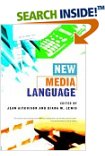new forms of language, rhetoric, and communication
This is a collection of papers given at a conference on ‘Language, Media, and International Communication’ at Oxford University. The contributions are from academics and journalists, and the best thing about them is that they are interestingly varied in topic and approach. Issues discussed include the manner in which the norms of communication in the English-speaking world are affecting speakers of other languages. The example given is of an assistant in MacDonald’s in Budapest who speaks Hungarian, but uses an Anglo-American ‘discourse’.
 Robin Lakoff also writes on the ‘new incivility’ – how swearing and bad manners have risen to the surface of public discourse, from the television chat show to the theatres of government in the west. Sometimes the arguments seem to take a sledgehammer to crack nuts. Martin Conboy’s otherwise excellent analysis of the language of hysterical chauvinism in The Sun could have been done without evoking references to Mikhail Bakhtin.
Robin Lakoff also writes on the ‘new incivility’ – how swearing and bad manners have risen to the surface of public discourse, from the television chat show to the theatres of government in the west. Sometimes the arguments seem to take a sledgehammer to crack nuts. Martin Conboy’s otherwise excellent analysis of the language of hysterical chauvinism in The Sun could have been done without evoking references to Mikhail Bakhtin.
Despite the title of the book, the emphasis is more on media than on language. John Carey looks at the problems of establishing credulity in reportage, and there’s a well-informed piece on the BBC’s anguish regarding the middlebrow nature of Radio 4.
One of the best pieces in the collection is by co-editor Diana Lewis on the changes brought about to the concept of news and the way it is broadcast as a result of now being simultaneously available in so many different forms. It comes at us in traditional manner via newspapers, radio, and television – but to these are now added instantly updated web sites, news feeds, and personal blogs – all of which can come along with a huge variety of background and contextual materials, available at the click of a hyperlink. Have a look at any page on a Wikipedia entry, and you’ll see what she means.
I also enjoyed an amusing piece from the Guardian columnist Malcolm Gluck on the difficulty of describing wines without slipping into Pseud’s Corner prose. At a more serious level, there’s an excellent piece analysing the duplicitous and rhetorical devices used in White House press briefings, where the official spokespeople try to give away as little as possible, and the press representatives try equally hard to make them admit the truth of what is going on.
There are two good chapters from professional lexicographers. John Ayto looks at the way in which newspapers create neologisms by what’s called ‘blending’ – as in motel comes from a blend of motor + hotel. John Simpson, one of the editors at the Oxford English Dictionary, considers the problem of accepting new media forms such as film, tabloids, and email as the sources for word definitions.
It certainly deals with traditional as well as new media – because there’s lots on the press, particularly the tabloids. This will be of interest to students of media, communication skills, politics, and current affairs, as well as anyone who follows trends in current language use.
© Roy Johnson 2004
Jean Aitchison and Diana M. Lewis, New Media Language, Abingdon: Routledge, 2003, pp.209, ISBN: 0415283043
More on digital media
More on technology
More on theory